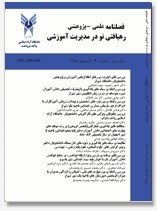تحلیل روایت نگارانه ی ادراک و تجربه زیسته راهبران آموزشی از اجرای الگوهای نظارت آموزشی معلم-محور در مدارس ابتدایی: تدوین و اعتباریابی الگوی بومی
محورهای موضوعی : آموزش و پرورشمحسن ایزان 1 , مصطفی قادری 2 , ناصر شیربگی 3
1 - دانشجوی دکتری مدیریت آموزشی، دانشکده علوم انسانی و اجتماعی، دانشگاه کردستان، سنندج، ایران
2 - دانشیار گروه مطالعات برنامه درسی دانشگاه علامه طباطبایی
3 - دانشیار گروه مدیریت آموزشی دانشگاه کردستان
کلید واژه:
چکیده مقاله :
پژوهش حاضر به هدف تحلیل روایت نگارانه ی ادراک و تجربه زیسته راهبران آموزشی از اجرای الگوهای نظارت آموزشی معلم-محور در مدارس ابتدایی و تدوین و اعتباریابی یک الگوی بومی انجام گرفت. روش پژوهش آمیخته اکتشافی بود. مرحله کیفی به روش روایت پژوهی و با رویکردی هدفمند (روش نمونه گیری موارد مطلوب)، مشارکت کنندگان از میان راهبران آموزشی استان آذربایجان غربی تا رسیدن به نقطه اشباع نظری انتخاب شدند و با آن ها مصاحبه های کیفی نیمه ساختارمند انجام شد. محاسبه اﻋﺘﺒﺎر و رواﯾﯽ دادهها با استفاده از دو روش ﺑﺎزﺑﯿﻨﯽ مشارکتکنندگان و ﻣﺮور ﺧﺒﺮﮔﺎن ﻏﯿـﺮ شرکتکننده در ﭘﮋوﻫﺶ انجام گرفت. با تحلیل مضمون، 6 مضمون سازمان دهنده و 22 مضمون پایه درباره الگوی نظارت معلم محور کشف گردید. برای اعتباریابی الگو، بخش کمی به روش تحقیق توصیفی پیمایشی انجام شد. با استفاده از فرمول نمونه گیری کوکران 120 نفر از راهبران آموزشی استان آذربایجان غربی انتخاب شدند. ابزار مورداستفاده در بخش کمی، مقیاس محقق ساخته بر اساس شبکه مضامین بخش کیفی بود. در بخش کمی برای تعیین اعتبار الگو تحلیل عاملی تأییدی انجام شد. نتایج بخش کمی با استفاده از تحلیل عاملی مرتبه اول و دوم نشان داد که الگوی بومی نظارت معلم محور دارای روایی سازه است.
The purpose of this study was the narrative analysis of the perceptions and lived experience of educational leaders of the implementation of Teacher-Oriented Educational Monitoring Patterns in Elementary Schools and the preparation and validation of a native pattern. The research method was exploratory mixed. The Qualitative stage by the method of research narration and with a targeted approach (the method of desirable sampling), participants from educational leaders of West Azarbaijan province were selected to reach the theoretical saturation point and semi-structured interviews were conducted with them. Calculation of reliability and validity of the data was done using two methods of reviewing the participants and reviewing non-participating experts in the research. By analyzing the theme, were dicovered 6 organizing themes and 22 basic themes about the teacher-centered model of supervision. To validate the pattern, a quantitative section was conducted using descriptive survey method. Using Cochran sampling formula, 120 educational leaders from West Azarbaijan Province were selected. The tool used in the quantitative section was a researcher-made scale based on the qualitative section themes network. In the quantitative part, a confirmatory factor analysis was conducted to determine the validity of the pattern. The results of the quantitative part, using first and second order factor analysis, showed that the teacher-centric the teacher-centered supervision model of native has structural validity.


